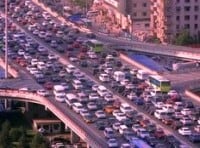
FUEL AND FOOD CRISIS SPARKS NEW GLOBAL INFLATION SPIRAL

Millions of automobiles and western lifestyles push China's consumption beyond sustainable limits. It's another '70s style stagflation scenario.
- Dateline
- 25 August 2017
Even as computers and electronic devices become as cheap as the value of their waste components, prices are rocketing up for gasoline, diesel and food products. Although rice is still relatively cheap, “Only peasants eat that stuff,” according to Chinese auto workers.
Cars are now one of China’s biggest products; production is at 20 million units per year and climbing. Most of those autos stay in China, and guzzle their share of gas, even though engines are pretty frugal these days.
The booming middle class in China reminds one of Japanese workers 45 years ago. They all want cars, burgers and weekends off. Which means meat and potatoes, and of course fuel for all those cars, just keep getting more and more expensive.
Three-day traffic jams have done nothing to dampen the Chinese appetite for a personal automobile. At this rate, Beijing is going to become the world’s first city with 24-lane highways.
As shortages bite, cars queue at gas stations for miles, and black-market fuel has taken over from counterfeit designer goods as the most heavily traded back-alley commodity.
Despite rapid advances in biotech and GM crops, China is suffering from a paradigm shift in demand patterns, and can’t keep up without massive imports from Africa and the West. While unused rice feeds the poor, the city workers want their grains and fatty foods. Sugar is also at a premium.
Oil prices are back to highs not seen since 2008. Biodiesel and electric cars have had an impact, but only in the luxury segment. And food prices account for more than one third of China’s inflation basket.
For the first time in over 150 years, commodity prices on the Chicago exchange are showing a sustained upturn in real terms. This super-cycle can only have one result: inflation.
ANALYSIS >> SYNTHESIS: How this scenario came to be
The Great Crawl of China
As the Economist so eloquently puts it, China tends to do things on a larger scale than most. But how sustainable is China’s new love affair with the automobile?
In 2002 China had a privately owned fleet of a mere 10 million vehicles. By 2006, 20 million cars and trucks; by 2010 over 40 million.
At current rates of doubling every 4 years, by 2017 there will be about 120 million private cars in China. Besides running out of roads for all these vehicles, where will the fuel come from? Can China build sufficient coal-to-liquid plants to minimize their imports, or do they have another ‘solution’ up their sleeves?
A fuel crisis for the region seems as inevitable as the traffic jams. And more expensive fuel will lead to more expensive food – an inflationary spiral.
Links to related stories
- China traffic jam stretching 100km enters ninth day - BBC News 23 August 2010
- Rice Rebounding in Widest Discount to Wheat Since Food Crisis Amid Floods - Bloomberg, 24 August 2010
- Food prices: The ghost of crisis past - Guardian, 13 August 2010
- There’s a new world order in food - Globe and Mail, 19 August 2010
- MindBullet: FUEL VS FOOD: THE WAR SPREADS (Dateline: 12 November 2013, Published: 24 April 2008)
- MindBullet: GM HYDROPONIC CROPS FEED A BILLION CHINESE (Dateline: 8 August 2012, Published: 27 March 2008)
- MindBullet: CLIMATE CHANGE & BACTERIA NOW BLAMED FOR FUEL CRISIS (Dateline: 19 August 2017, Published: 21 July 2005)
Warning: Hazardous thinking at work
Despite appearances to the contrary, Futureworld cannot and does not predict the future. Our Mindbullets scenarios are fictitious and designed purely to explore possible futures, challenge and stimulate strategic thinking. Use these at your own risk. Any reference to actual people, entities or events is entirely allegorical. Copyright Futureworld International Limited. Reproduction or distribution permitted only with recognition of Copyright and the inclusion of this disclaimer.